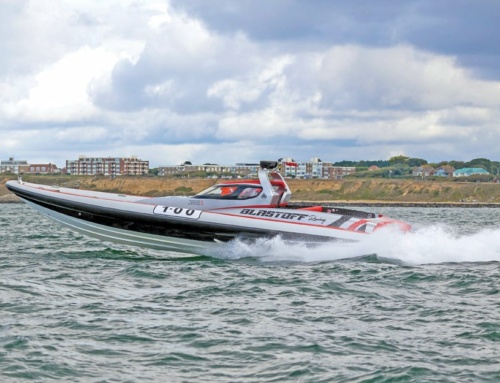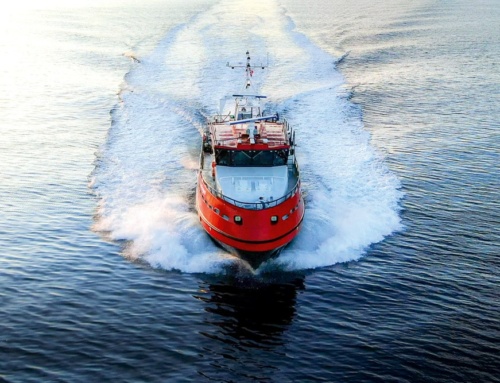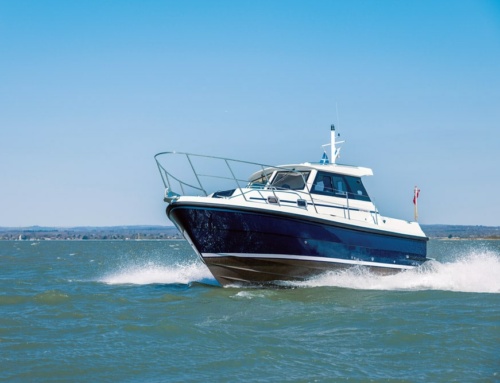- Remember that any boat/trailer combination over 750kg must have brakes fitted.
- While carrying out your checks, be sure to ‘feel’ for play in the wheel bearings.
- First and foremost, you need to ensure that your load is secure.
- Do not be tempted to sit a large, heavy boat on an unbraked trailer in an attempt to appear legal.
Towing the Line
Jonathan Peers discusses the legal requirements that boaters need to be aware of when towing their trailer …
If I were to offer any of PBR’s writers one piece of advice, it would be not to upset our editorial department. I wasn’t aware of having done that, but nevertheless, I was chosen to do the seemingly impossible – to somehow simplify towing laws and regulations. This is no easy task, so please bear with me!
For many of us, boats and towing go hand in hand; however, since 1st January 1997 there have been some changes in the regulations for drivers’ licences, and when coupled with better-educated police forces, we can start to feel like we are trapped in a minefield of red tape, with one false move resulting in prosecution.
Of course, the people who implement and enforce the rules will insist that it’s all about safety, and while I struggle to argue with this, I know that the majority of people who fall foul of the law will say that it’s all a way of making money and ruining people’s lives. Having spent the time and money in order to keep myself legal, I can see both sides of the argument, and for this reason I shall try to present a balanced view.
The way I see it, there are three main factors to consider when aiming to stay legal while towing: firstly the driver, or rather what the driver is actually licensed to tow; secondly the car and trailer combination, looking at towing weights and associated limitations; and lastly the set-up of the trailer, whether or not brakes are needed and maintaining it in a roadworthy condition.
At this point it should be noted that a full-size road-legal trailer cannot exceed a gross vehicle weight (GVW) of 3.5 tonnes (3500kg). Anything larger starts getting even more complicated, requiring a category C1 licence or above and things such as air brakes etc. Also, unbraked trailers generally have a GVW of up to 750kg. These weights include the weight of the actual trailer itself, and not just its load.
The driver
This is undoubtedly the aspect that causes the most controversy, as it would seem that the powers that be have shifted the goalposts to come in line with the rest of Europe, essentially putting a stop to new drivers automatically being able to tow large trailers – and vehicles over a GVW of 3.5 tonnes for that matter. This is not a new change, in fact the change came about in January 1997, but for a long time there wasn’t much awareness of what it all meant.
OK, so now let’s look at you. Did you pass your driving test before 1st January 1997? If you did, you are lucky enough to be able to tow any standard road-legal trailer, regardless of your actual driving abilities. That’s pretty cool, until I realise that my mother-in-law could quite legally jump into a fully loaded Transit van and tow a huge 3.5-tonne trailer without anyone questioning her competence. The reality is that if this were a real scenario, then the rest of the motoring public would be well advised to stay at home that day. So, with this in mind, maybe changing the law was the right thing to do.
For the more youthful among us (myself included) who passed our driving tests after 1st January 1997, things are a little different. In order for us to be able to tow a full-sized trailer, we need two little letters on our driving licence, i.e. category B+E. Category B refers to car and category E means trailer, so B+E is car plus trailer. In order to obtain this entitlement, a further driving test must be passed.
Having just the basic licence doesn’t stop you towing trailers altogether, but it does severely limit the weight of the trailer you are allowed to tow. The law states that you can drive a car and trailer with a GVW (plated weight) of 3500kg; however, if you are driving a vehicle (e.g. a van) you can still tow a trailer with a GVW of up to 750kg. This means that your rig would have a gross train weight (GTW = total car + trailer) of 4250kg. This does not however mean that you can tow your 6.5m RIB behind a Nissan Micra as this would be overloading the vehicle, since the law also states that any trailer must also be within the limits stated by the vehicle manufacturer – but I will cover this in the next chapter.
In boating terms, you can comfortably tow anything that sits on an unbraked trailer, i.e. most jet skis, inflatables, small speedboats and RIBs up to around 5m in length. If that suits you, then save your money and keep your licence as it is. Do not be tempted to sit a large, heavy boat on an unbraked trailer in an attempt to appear legal. If your trailer is weighed and found to be too heavy, thereby overloading the trailer, the penalties can be quite severe. Be sensible and do your research carefully to ensure that you stay on the right side of the law. Be assured that as far as towing laws go, as complicated as they may seem, there are no ‘grey areas’ or ‘loopholes’, and pleading ignorance is no defence. The police have recently been using social media to highlight cases where they have impounded caravans due to the driver not having B+E on their licence. Imagine not only the financial penalties issued by a court, and the transport and storage costs associated with having your trailer impounded, but also missing out on your caravan holiday, or your time afloat.
OK, so maybe you now believe that you are not licensed to tow your boat. What now? Well, unfortunately you have no choice but to take the B+E driving test.
The test itself is essentially based on an LGV C+E (articulated lorry) test, and as such is carried out at an LGV test centre. Here you will perform an ‘S’ shape reverse manoeuvre into a coned-off parking place, demonstrate safe hitching and unhitching, and answer a few test questions. Sounds simple, right? Well actually, yes – if you slow yourself down and employ a methodical approach there is nothing too scary about this part of the test. The tricky bit for most people (myself included) is being able to pass the driving assessment. Let’s face it, how many people still drive like they did when they passed their original driving test? Not many, I would say, so unless you are absolutely certain about your own driving skills, I would strongly recommend employing the services of a qualified B+E driving instructor, as not only will they help rid you of your many and varied bad habits, but they will also prepare you for the test itself.
In recent years, a number of specialist B+E driving schools have emerged, catering nicely for the ever-growing number of people who find themselves unable to tow. Interestingly, and not wanting to sound in any way sexist, a lot of female candidates take this test in order for them to be able to tow horseboxes. This should be of some comfort to anyone who may be concerned about this being a male-dominated, intimidating process to go through. The fact is that it is not.
One such instructor is Pete Walmsley of Drive 2 Succeed. Being based locally in Chorley, Lancashire, he was my first choice for helping me through my test, and he kindly agreed to meet up on a cold autumn afternoon in order to demonstrate the practical assessment, and run through the regulations.
Assessment demo
Pete begins his demonstration by walking around the trailer to carry out a quick but methodical check of all its parts – hitch, handbrake, breakaway cable, jockey wheel, lights, tyres, and of course a check to ensure that the load itself is secure.
Next he demonstrates how to safely unhitch the trailer, and hitch back up, while also taking the time to explain how important it is to have the correct nose weight on the hitch, and how this can be checked.
Pete then sets out, with cones, an imaginary garage for reversing into. This is made the same length as the car/trailer combination, just as would happen at the test centre in order to suit whatever vehicle you use on the day. Further cones are positioned to mark the limits of the turning area. What follows is the one and only reversing exercise in the entire test. Quite simply, the trailer must be reversed in an ‘S’ shape into the garage, with the rear of the trailer lining up inside a yellow hatched area painted on the road, and with only one forward shunt to straighten things up should things not go quite to plan. If your reversing skills are somewhat poor, then don’t worry, as a good proportion of your lesson time will be spent perfecting this move in order to get you through the test.
What Pete has just demonstrated is what takes place on the proving ground at the test centre itself. The rest of the test takes place on public roads and adopts the form of a normal driving test, hence the reason for getting rid of all those nasty habits. After all, it doesn’t matter if you are capable of reversing your trailer blindfolded, as if, when on your road assessment, you don’t drive with both hands on the wheel, and check your mirrors often enough, you will fail the test.
The car/trailer combination
As long as you are sensible, it need not be all doom and gloom, so let’s look on the bright side. Using Pete’s Skoda Yeti as an example, we’ll take a look at the chassis plate to see what we can actually tow without having to pass the B+E test. This is where things can seem confusing, but if you grab yourself a calculator, it will all begin to make sense.
The top line shows the maximum allowable weight, or GVW, of the car at 2105kg, and the second line shows the maximum allowable train weight, or GTW, of the vehicle, i.e. the car and trailer weight together, at 4205kg. If we subtract the weight of the vehicle from the train weight, we arrive at the weight of trailer that the car is capable of towing, which in this case is 2100kg. The next two figures are the maximum permitted axle weights, with axle one (front) rated at 1100kg and axle two (rear) at 1040kg. This, of course, is no good if you don’t have the right licence, as without it, you are limited to a GTW of 3500kg, so let’s start working out what you can tow.
These calculations apply to any car, so take a look at your own, or any car you are considering buying, and do this. Start with the figure of 3500kg (your maximum train weight), then subtract the maximum weight of the car – which in the case of the Skoda Yeti is 2105kg. The answer here is 1395kg of actual weight that you can tow behind this car to keep within the category B threshold of a GVW of 3500kg. To be fair, this isn’t a bad size of trailer and would allow you to tow many small to medium-sized RIBs, but again, be careful as we now need to look at the chassis plate on the trailer itself. For example, if your trailer has a GVW of 1300kg, this would be suitable for a standard category B licence.
Just as with the car, the maximum weight stamped on the plate is what matters as far as the law is concerned, and not the actual weight. This to me is a bit unfair as you could technically be prosecuted for towing an empty trailer. In cases such as this, however, I would hope that common sense would prevail – but I wouldn’t count on it.
Looking at the chassis plate on Pete’s trailer, we can see that it is rated at 1400kg, meaning that it is very close to being legally towed on a standard licence, behind the Yeti. The fact remains, however, that although it is only 5kg too heavy, it is enough for you to be breaking the law. In this situation you could possibly get the trailer manufacturer to fit a ‘lighter’ plate, but the trailer could only ever be legally able to carry this new weight limit. If you are shopping for a new car, look at the chassis plates on the different models in order to determine the best combination that suits your needs.
The trailer
Now that you have worked out whether or not you need to take the B+E test, and whether or not your car is suitable for towing, you may be dismayed to hear that your worries are far from over. As the driver, it is your responsibility to ensure that the trailer itself is well maintained in a roadworthy condition. Unlike cars, trailers are not subject to an annual MOT (as yet), which would normally be the time when most potential problems would be detected. That said, you are left to either employ the services of a trailer repair centre or get your hands dirty and do the work yourself. Information on how to carry out various jobs on the trailer can be found easily on the Internet, and most work requires only basic tools and a little patience.
First and foremost, you need to ensure that your load is secure. In the case of a boat, this means using ratchet straps from the bow ring and rear towing eyes to ensure that the boat and trailer become one unit. If your boat doesn’t have towing eyes, you will need to find an alternative solid point on the boat from which to secure it to the trailer. This could possibly mean feeding the strap through the saddle bracket of the outboard. Never, ever rely solely on the winch strap to hold the boat, as not only can the winch fail, but the rear of the boat is left unsecured and will end up bouncing – damaging both the boat and the trailer itself. If you are towing a RIB, never run the straps over the tubes, as not only will they rub, causing damage, but the soft nature of the tubes means that the straps will keep going slack during transit. Having an unsecure load is a traffic offence in itself, so it makes sense to get this right.
With the load secured in place, it is important to check the nose weight – this quite simply is the weight that the trailer will be pushing downwards onto the vehicle’s tow bar. The legal minimum weight is 25kg, and while your trailer may have a recommended higher rating, you will need to consult the handbook of the tow vehicle to see what the maximum load for the car is. Checking the weight is a simple job. If you are towing lots of different trailers, then you may want to invest in a dedicated nose weight gauge, but for a one-time set-up, a piece of wood and a set of bathroom scales with do the job nicely!
The real bugbear among us boaters is the issue of brakes. Despite the number of manufacturers producing boat trailers, it would seem that it hasn’t occurred to any of them to develop braking systems that are suited to being dipped in the salty stuff, and so resist corrosion. Even with regular flushing with fresh water, the salt eventually destroys all the components inside the drums. What many people often choose to do (quite understandably) is strip out the brakes so as to avoid the problems associated with sticking drums. Let me be quite clear now – doing this is illegal, and you will be prosecuted. Police forces are well aware of this practice, and have been known to target boat trailers in order to check that the brakes are not only in place, but also working as they should. Of course, if you really want a simple boating life, you can always consider sticking with a small boat, which will be light enough to sit on an unbraked trailer. Remember that any boat/trailer combination over 750kg must have brakes fitted.
While carrying out your checks, be sure to ‘feel’ for play in the wheel bearings. To do this, you simply jack up the trailer, take a firm hold of the wheel on opposite sides and try wobbling the latter. Any play will be obvious and will need the bearings to be either adjusted or replaced. At the same time, spinning the wheel will enable you to listen for any rumbling noise – this can also be a sign of worn bearings.
Other than a fully functioning lighting board, and displaying the correct rear number plate, the last thing to keep the authorities happy is the breakaway cable or secondary coupling. In the case of an unbraked trailer, you must fit what is known as a secondary coupling – which, as the name suggests, is a loop of steel cable or chain that will keep the trailer attached to the car should the main hitch fail. On a braked trailer, you must use a breakaway cable. This is a flimsy-looking cable that is fastened to the trailer’s braking mechanism, and clipped to the towing vehicle. In the event of the trailer becoming detached, the cable will cause the trailer’s handbrake to be activated before snapping, or ‘breaking away’. The purpose of this is to bring a heavy trailer to a stop, rather than having it swinging off the back of the car, or worse, overtaking the car and causing an accident. And in case you haven’t guessed already, failing to use one of these will result in prosecution!
To round things up, I would say that it makes sense to keep everything legal and above board. Not only will this help make your journeys less stressful, but it will also keep things safer for you, and other road users too.
For further info
Government website: www.gov.uk/towing-with-car
National Trailer and Towing Association: www.ntta.co.uk/suppliers/be-driving-schools/
RAC’s caravan towing guide: www.rac.co.uk/drive/advice/driving-advice/towing-a-caravan/
For matching caravans to cars and a source of technical specs: www.towcar.info/GB/
Photos: Thomas Peers













